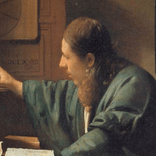
Johannes Vermeer
Johannes Vermeer's work still captivates the imagination to this day. The distinctive colors and seemingly simple, serene compositions make his paintings highly recognizable. Johannes Vermeer painted differently from his contemporaries, and it's precisely what makes him a typical observer, someone who looked at society from a distance and captured what he saw with keen precision. Discover Vermeer's unique perspective with the fun part of art.
The Life of Johannes Vermeer
Johannes Vermeer was born in 1632 in Delft, where he was also baptized in the Protestant church. His father, Reynier Janszoon Vermeer, was a weaver and innkeeper. Johannes was born in the Delft inn called "De Vliegende Vos," not far from the Grote Markt. Johannes Vermeer's mother, Digna Baltens, was born in Antwerp, and his family had Antwerp origins on his father's side as well. During this period, many Flemish people immigrated to Holland, so Johannes likely heard a lot of Flemish during his early years.
When Johannes was eight years old, his family moved to the Mechelen Inn, located on Delft's Grote Markt, a bustling establishment in 17th-century Delft. The Sint-Lucas artists' society, where Johannes Vermeer's father was a member, as were other family members, was just around the corner. This gives us a glimpse into the social network of young Johannes Vermeer, which included many artists and prosperous Delft citizens.
In 1650, when Johannes Vermeer was only 18, something changed in Delft. Delft painters suddenly started working more with perspective and seemed to adopt a more technical approach to their work. This change was likely driven by the influence of the great painter Carel Fabritius, who settled in Delft in 1650. Vermeer might have known him, but whether he was Fabritius' pupil was never proven. We know very little about Vermeer's training. He quickly developed his own style, showcasing his independent talent.
Johannes Vermeer joined the Sint-Lucas Guild in 1653. In the same year, he married the Catholic Trijntje Bolnes. To marry her, Vermeer had also converted to Catholicism, a difficult step during a time when Catholics were socially disadvantaged. The painter Leonard Bramer, a friend, facilitated this conversion.
On October 12, 1654, the Delft Thunderclap occurred, a massive explosion heard as far away as Texel. An ammunition depot had caught fire, resulting in a devastating explosion that destroyed a significant portion of Delft and claimed hundreds of lives. Carel Fabritius also perished in this catastrophe. In the period following the disaster, Vermeer emerged as Delft's most famous painter and was considered by contemporaries to be Fabritius' successor, even though he had his own distinct style, and it's unlikely he was Fabritius' student.
Vermeer made his living as an art dealer and was reputed to have extensive knowledge of art, which was highly regarded by his contemporaries. Although his own paintings were highly valued, he produced so few that it's improbable he could have sustained himself through his art alone. He likely remained involved in his parents' inn, Herberg Mechelen. His mother-in-law owned a large house where Johannes lived and also had his studio.
The economic crisis that began in 1672, known as the "Rampjaar" or "Disaster Year," hit Vermeer hard. Sudden poverty left him in despair, and according to his wife, he went from being a healthy man to a wreck in a day and a half. He did not recover from the blow and died.
Works by Johannes Vermeer
Johannes Vermeer's work holds a unique place within 17th-century painting. His sense of composition, precision, and use of color make him truly exceptional. Whether the general public was interested in his work is unclear, but it's certain that he enjoyed a good reputation among art connoisseurs. Vermeer brought something new to the table, and a group of true enthusiasts highly appreciated it.
Various themes from Vermeer's life can be recognized in his paintings. Delft, the city that was destroyed and then rebuilt, is the subject of his impressive "View of Delft." However, Vermeer's paintings truly bring to life the daily existence in that city. A frequently used backdrop is a room with a window on the left, allowing sunlight to stream in.
A peculiar aspect is that some clothing items of his wife, who was naturally nearby when he wanted to paint, reappear in several paintings. This is also the case in "The Milkmaid," perhaps his most famous work. His father had been a weaver and a fabric merchant, which might explain Johannes Vermeer's interest in such details. His unique use of color may also be related to this.
Yet, the most extraordinary aspect of Vermeer's work is its astounding clarity. Vermeer mastered the technique like no other. He may have used the "camera obscura," a precursor to the camera, for his work. Not only is Vermeer's detailing and use of light photorealistic, but his perspective is also flawless. That's why his paintings feel modern.
Johannes Vermeer & the Fun Part of Art
Stunning, surprising, magical: Johannes Vermeer's paintings create a world of their own. Bas Zevenbergen will tell you in his online museum about the symbolism you can find in these beautiful works. That's how 17th-century Delft truly comes to life. That's the fun part of art.